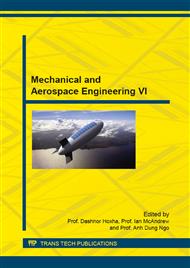[1]
J. Koch and J. Mazumder: Apparatus and methods for monitoring and controlling multi-layer laser cladding, US patent no. 6122564, (2000).
Google Scholar
[2]
P. K. Venuvinod and W. Ma: Rapid prototyping: laser-based and other technologies, 1st edn, 6; (2001), Norwell, Kluwer Academic Publishers.
Google Scholar
[3]
E. Brandl, Microstructural and mechanical properties of additive manufactured titanium (Ti-6Al-4V) using wire, Shaker Verlag, Aachen, Germany, (2010).
Google Scholar
[4]
W.U.H. Syed, A.J. Pinkerton, L. Li, Appl. Surf. Sci. 252 (2006) pp.4803-4808.
Google Scholar
[5]
I.R. Pashby, S.H. Mok, J. Folkes, Proceedings of 23rd International Congress on Applications of Lasers and Electro-Optics, San Francisco, CA, USA, (2004), pp.18-24.
Google Scholar
[6]
W.U.H. Syed, L. Li, Appl. Surf. Sci. 248 (2005) pp.518-524.
Google Scholar
[7]
W.U.H. Syed, A.J. Pinkerton, L. Li, 23rd International Congress on Applications of Lasers and Electro-Optics, San Francisco, CA, USA, 5. (2004).
Google Scholar
[8]
F.D. Wang, S. Williams, P. Colegrove, A. A. Antonysamy, Microstructure and Mechanical Properties of Wire and Arc Additive Manufactured Ti-6Al-4V, , Metallurgical and Materials Transaction A, Vol 43A, (2012).
DOI: 10.1007/s11661-012-1444-6
Google Scholar
[9]
ASTM F3001-14, Standard Specification for Additive Manufacturing Titanium-6 Aluminum-4 Vanadium ELI (Extra Low Interstitial) with Powder Bed Fusion, ASTM International, West Conshohocken, PA, (2014).
DOI: 10.1520/f3001-13
Google Scholar
[10]
G. Lutjering and J.C. Williams: Tittanium, 2nd ed., Springer, Berlin, (2007), p.8.
Google Scholar
[11]
C.H. Che-Harona and A. Jawaidb: J. Mater. Process. Technol., Vol. 166, (2005), pp.188-92.
Google Scholar
[12]
S. Li. Gong and H.B. Suo: Develoment and Application of Metal Additive Manufacturing Techology, J. Aeronautical Manufaturing Technology, Vol. 13, (2013), pp.66-71.
Google Scholar
[13]
D. D Gu, W. Meiners, K. Wissenbach and R. Poprawe, Laser additive manufacturing of metallic components: materials, processes and mechanisms, International Materials Reviews, Vol. 57, (2012), pp.133-163.
DOI: 10.1179/1743280411y.0000000014
Google Scholar


